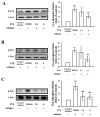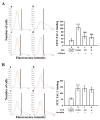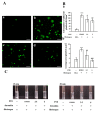The Antithrombotic Agent Pterostilbene Interferes with Integrin αIIbβ3-Mediated Inside-Out and Outside-In Signals in Human Platelets
- PMID: 33807403
- PMCID: PMC8037547
- DOI: 10.3390/ijms22073643
The Antithrombotic Agent Pterostilbene Interferes with Integrin αIIbβ3-Mediated Inside-Out and Outside-In Signals in Human Platelets
Abstract
Platelets play a crucial role in the physiology of primary hemostasis and pathological processes such as arterial thrombosis; thus, developing a therapeutic target that prevents platelet activation can reduce arterial thrombosis. Pterostilbene (PTE) has remarkable pharmacological activities, including anticancer and neuroprotection. Few studies have reported the effects of pterostilbene on platelet activation. Thus, we examined the inhibitory mechanisms of pterostilbene in human platelets and its role in vascular thrombosis prevention in mice. At low concentrations (2-8 μM), pterostilbene strongly inhibited collagen-induced platelet aggregation. Furthermore, pterostilbene markedly diminished Lyn, Fyn, and Syk phosphorylation and hydroxyl radical formation stimulated by collagen. Moreover, PTE directly hindered integrin αIIbβ3 activation through interfering with PAC-1 binding stimulated by collagen. In addition, pterostilbene affected integrin αIIbβ3-mediated outside-in signaling, such as integrin β3, Src, and FAK phosphorylation, and reduced the number of adherent platelets and the single platelet spreading area on immobilized fibrinogen as well as thrombin-stimulated fibrin clot retraction. Furthermore, pterostilbene substantially prolonged the occlusion time of thrombotic platelet plug formation in mice. This study demonstrated that pterostilbene exhibits a strong activity against platelet activation through the inhibition of integrin αIIbβ3-mediated inside-out and outside-in signaling, suggesting that pterostilbene can serve as a therapeutic agent for thromboembolic disorders.
Keywords: arterial thrombosis; hydroxyl radicals; integrin αIIbβ3; platelet aggregation; pterostilbene; resveratrol derivative.
Conflict of interest statement
The authors declare no conflict of interest.
Figures







References
-
- Zhu Q., Tang T., Liu H., Sun Y., Wang X., Liu Q., Yang L., Lei Z., Huang Z., Chen Z., et al. Pterostilbene attenuates cocultured BV-2 microglial inflammation-mediated SH-SY5Y neuronal oxidative injury via SIRT-1 signaling. Oxid. Med. Cell. Longev. 2020 doi: 10.1155/2020/3986348. - DOI - PMC - PubMed
-
- Park E.-S., Lim Y., Hong J.-T., Yoo H.-S., Lee C.-K., Pyo M.-Y., Yun Y.-P. Pterostilbene, a natural dimethylated analog of resveratrol, inhibits rat aortic vascular smooth muscle cell proliferation by blocking Akt-dependent pathway. Vascular Pharmacol. 2010;53:61–67. doi: 10.1016/j.vph.2010.04.001. - DOI - PubMed
MeSH terms
Substances
Grants and funding
LinkOut - more resources
Full Text Sources
Other Literature Sources
Miscellaneous

